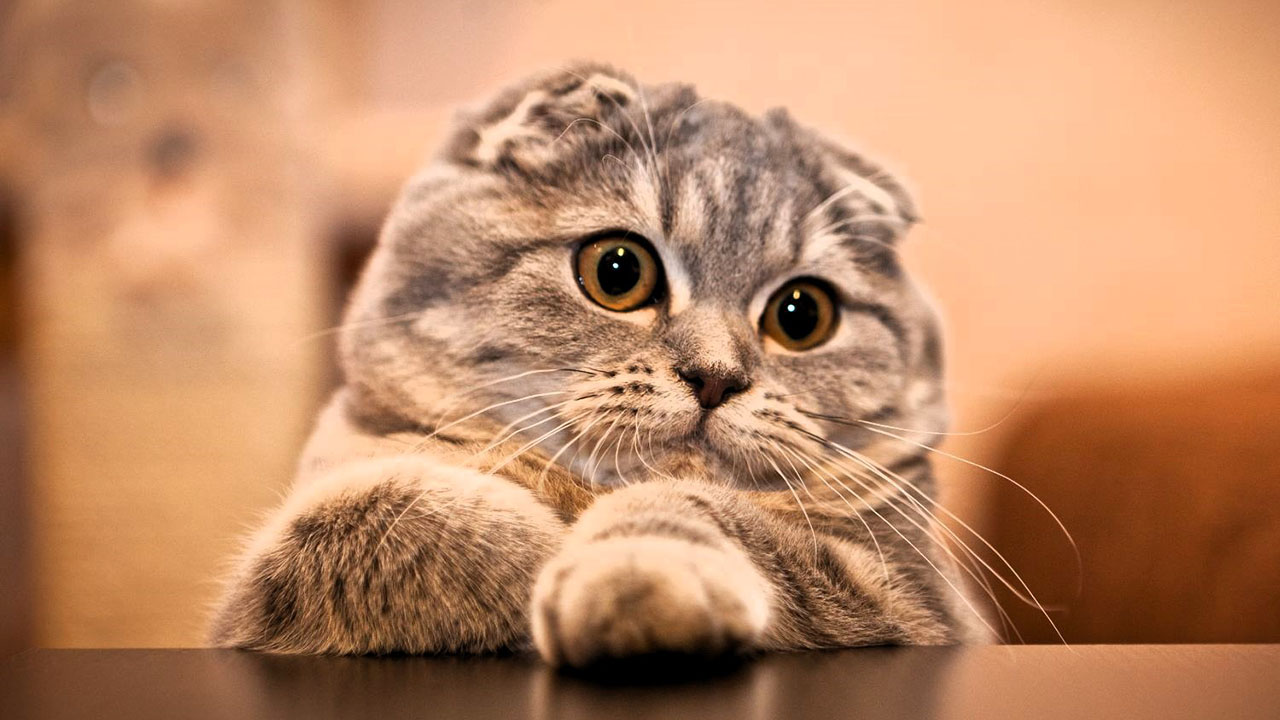When it comes to the diverse world of cat breeds, cats with floppy ears hold a special place in the hearts of cat enthusiasts. These unique and often rare breeds are visually striking and known for their distinctive personalities. This comprehensive guide will explore the top 10 cats with floppy ears. From their origins to their care needs, join us in discovering what makes each of these floppy-eared cats unique.
Table of Contents
What are Floppy Ears in Cats?
Floppy ears in cats are a unique physical trait where the cat’s ear tends to droop or fold forward, differing from the typical erect and pointed ears seen in most cat breeds. This characteristic is often the result of a genetic mutation, which, in some cases, has been selectively bred over generations. While adorable, it’s essential to note that floppy ears can sometimes lead to unique health considerations, such as increased susceptibility to ear infections or challenges in cleaning. Understanding these aspects is crucial for any potential cat owner.
Why Are My Cats Ears Floppy?
If your cat’s ears are floppy, there could be a few reasons:
- Breed Characteristics: If your cat is a Scottish Fold or American Curl, floppy or bent ears are a natural and breed-specific trait due to genetic mutations.
- Health Issues: In cats that are not of a breed with naturally floppy ears, this could indicate a health problem. Ear infections, injuries, or other medical conditions can cause a cat’s ears to droop.
- Relaxation: Sometimes, cats might temporarily have floppy ears when they are extremely relaxed or sleepy. This is normal and not a cause for concern.
- Dehydration or Weakness: In some cases, floppy ears could be a sign of dehydration, weakness, or general ill health.
If your cat’s floppy ears are accompanied by signs of discomfort or changes in behavior, or if they are persistently floppy without a clear reason (like being a Scottish Fold or American Curl), it is advisable to consult a veterinarian for a proper diagnosis and treatment.
Top 10 Cats With Floppy Ears or Folded Ears
Following are the top 10 best cat breeds with floppy and folded ears:
Scottish Fold
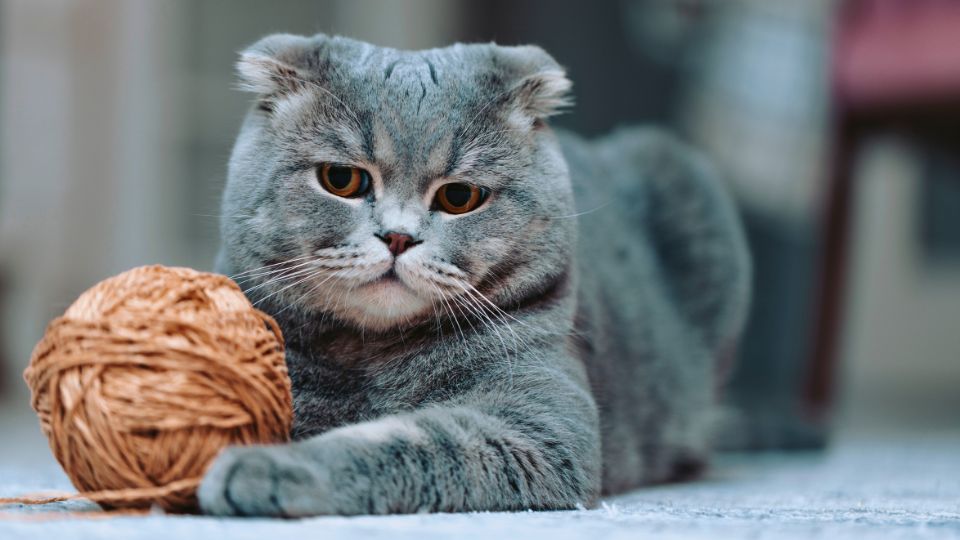
One of the most iconic floppy-eared cat breeds is the Scottish Fold. Originating from a farm in Scotland in the 1960s, these cats are known for their unique ear structure caused by a natural genetic mutation. The Scottish Fold’s ears fold forward and downward, giving them an almost owl-like appearance. These cats are typically calm and good-natured and enjoy both play and relaxation equally. As for care, regular ear checks are vital to prevent ear infections in cats, and gentle handling is necessary to protect their unique cartilage.
Here is a characteristics table for the Scottish Fold cat:
| Characteristic | Details |
|---|---|
| Origin | Scotland |
| Lifespan | 12-15 years |
| Temperament | Sweet-tempered, affectionate, calm |
| Physical Traits | Medium-sized, round face, folded ears, various coat colors and patterns |
| Health Concerns | Prone to osteochondrodysplasia, heart diseases, and arthritis |
| Care Needs | Regular grooming, ear cleaning, and health monitoring |
| Activity Level | Moderate; enjoys playful interactions but also likes relaxing |
American Curl

Next on our list is the American Curl, recognized for its unusual, backward-curling ears. This cat breed emerged in California in the 1980s and quickly became famous for its playful and affectionate nature. American Curls are adaptable, making them suitable for various living situations, including families with children and other pets. Their ears require minimal special care, but regular grooming is necessary to maintain their health and coat condition, like all cats.
Here is a characteristics table for the American Curl cat:
| Characteristic | Details |
|---|---|
| Origin | United States |
| Lifespan | 12-16 years |
| Temperament | Friendly, affectionate |
| Physical Traits | Curled ears, various coat types |
| Health Concerns | Healthy, few genetic issues |
| Care Needs | Regular grooming, ear care |
| Activity Level | Moderate |
Highland Lynx
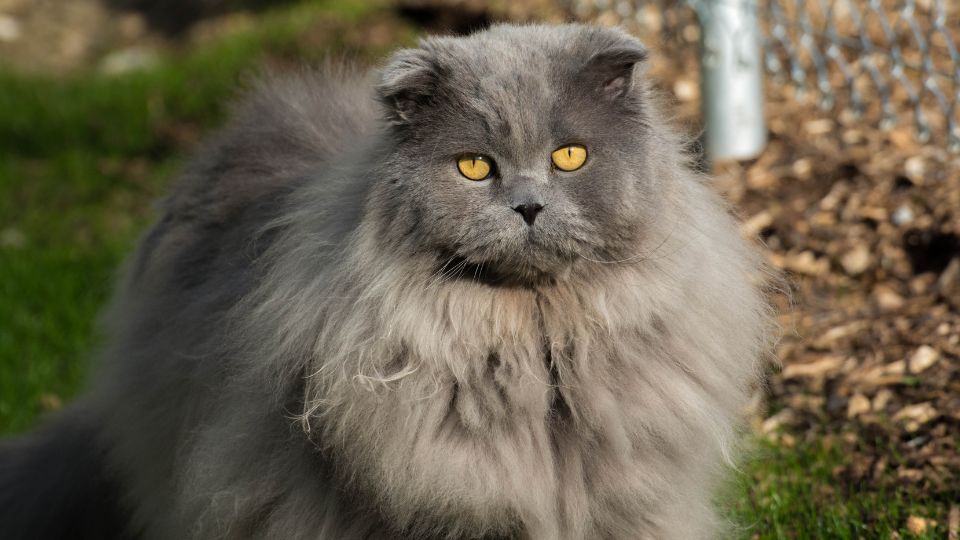
The Highlander cat, also known as the Highland Lynx, is a striking breed with a robust and muscular build. Their ears are floppy and often curled and tufted, contributing to their wild appearance. Highlanders are known for their playful and outgoing nature, making them excellent companions. Despite their fierce look, they are gentle and good with families. Regular play and exercise are crucial for this energetic breed.
Here is a characteristics table for the Highlander cat:
| Characteristic | Details |
|---|---|
| Origin | United States |
| Lifespan | 10-15 years |
| Temperament | Playful, affectionate |
| Physical Traits | Muscular, curled ears |
| Health Concerns | Generally healthy |
| Care Needs | Regular exercise, grooming |
| Activity Level | High |
Selkirk Rex

The Selkirk Rex stands out with its plush, curly coat and distinctive floppy ears. This breed, originating in the United States in 1987, is known for its incredibly soft, wool-like fur and gentle, patient behavior. These cats are particularly good with children and other pets, making them ideal family companions. The Selkirk Rex requires regular grooming to maintain its curly coat and to prevent matting. Selkirk Rex’s floppy ears should be checked regularly to ensure they are clean and healthy.
Here is a characteristics table for the Selkirk Rex cat:
| Characteristic | Details |
|---|---|
| Origin | United States |
| Lifespan | 12-15 years |
| Temperament | Calm, patient |
| Physical Traits | Curly coat, rounded ears |
| Health Concerns | Prone to kidney issues |
| Care Needs | Regular grooming |
| Activity Level | Moderate |
Peterbald
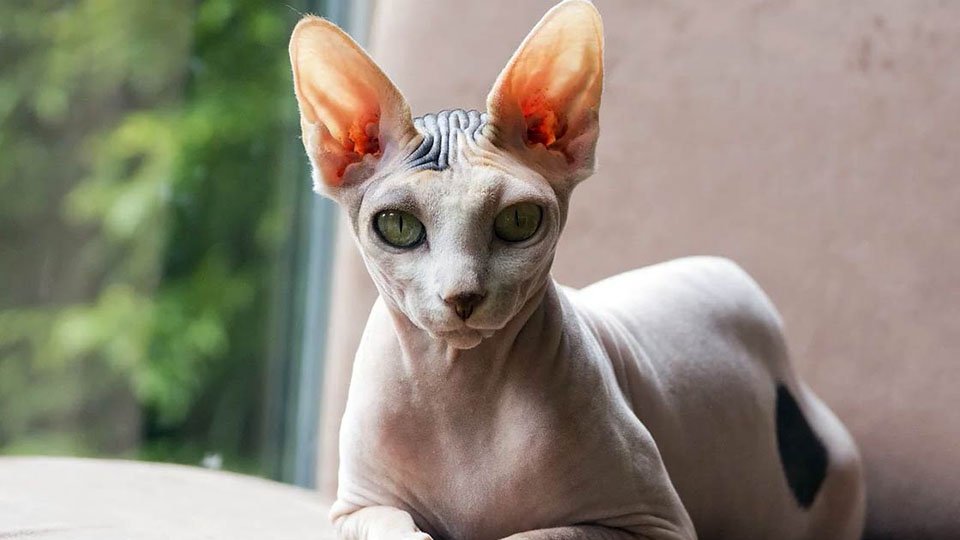
The Peterbald, hailing from Russia, is known for its elegant, slender build and various coat types, ranging from bald to fuzzy. Some Peterbalds exhibit the floppy ear trait, adding to their unique appearance. These cats are known for their affectionate and friendly nature, often seeking attention and interaction from their human companions. They are playful, intelligent, and adapt well to indoor living. Due to their unique coat, they may require special skincare.
Here is a characteristics table for the Peterbald cat:
| Characteristic | Details |
|---|---|
| Origin | Russia |
| Lifespan | 12-15 years |
| Temperament | Affectionate, social |
| Physical Traits | Slim, various coat types |
| Health Concerns | Prone to health issues |
| Care Needs | Skin care, grooming |
| Activity Level | High |
Devon Rex

The Devon Rex, with its large, low-set ears that sometimes appear floppy, is known for its elfin face and soft, wavy fur coat. Originating in England during the late 1950s, this breed is playful, mischievous, and highly affectionate. Devon Rex cats are known for their dog-like loyalty and enjoy involvement in family life. They require regular grooming to keep their coat in good condition and to minimize shedding.
Here is a characteristics table for the Devon Rex cat:
| Characteristic | Details |
|---|---|
| Origin | United Kingdom |
| Lifespan | 10-15 years |
| Temperament | Playful, loyal |
| Physical Traits | Wavy coat, large ears |
| Health Concerns | Prone to health issues |
| Care Needs | Regular grooming |
| Activity Level | High |
Cornish Rex

Like the Devon Rex, the Cornish Rex features an even more pronounced set of large, floppy ears. This breed originated in Cornwall, England, and is distinguished by its soft, curly coat and slender body. Cornish Rex cats are highly energetic and playful, often described as kitten-like throughout their lives. They love human interaction and are known for their acrobatic antics. Regular grooming and ear care are essential for maintaining their health and appearance.
Here is a characteristics table for the Cornish Rex cat:
| Characteristic | Details |
|---|---|
| Origin | United Kingdom |
| Lifespan | 11-15 years |
| Temperament | Active, playful |
| Physical Traits | Curly coat, slim body |
| Health Concerns | Prone to health issues |
| Care Needs | Regular grooming |
| Activity Level | High |
Sphynx

The Sphynx is widely recognized for its lack of fur but also features distinctive large, floppy ears. Originating in Canada in the 1960s, this breed is known for its extroverted behavior, high energy, and affection towards its owners. The Sphynx’s skin requires regular cleaning to remove oil buildup, and although they lack fur, they still need protection from extreme temperatures. Their prominent ears require regular cleaning to prevent dirt accumulation.
Here is a characteristics table for the Sphynx cat:
| Characteristic | Details |
|---|---|
| Origin | Canada |
| Lifespan | 8-14 years |
| Temperament | Loving, energetic |
| Physical Traits | Hairless, wrinkled skin |
| Health Concerns | Skin issues, heart disease |
| Care Needs | Skin care, bathing |
| Activity Level | High |
LaPerm

The LaPerm, known for its curly coat and often floppy ears, is a breed that originated in the United States. These cats are affectionate and friendly and enjoy being part of the family. They are known for their gentle and playful nature, often forming strong bonds with their owners. The LaPerm’s curly coat is surprisingly easy to maintain, but regular grooming is necessary to prevent mats and tangles.
Here is a characteristics table for the LaPerm cat:
| Characteristic | Details |
|---|---|
| Origin | United States |
| Lifespan | 12-15 years |
| Temperament | Affectionate, gentle |
| Physical Traits | Curly coat, normal ears |
| Health Concerns | Generally healthy |
| Care Needs | Low-maintenance grooming |
| Activity Level | Moderate |
Oriental Shorthair
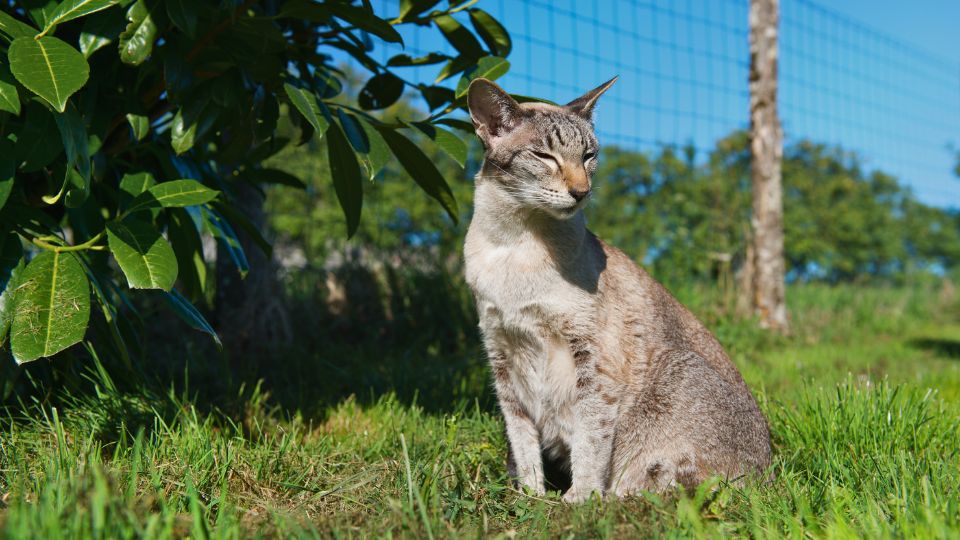
Finally, the Oriental Shorthair, while typically known for its large, pointed ears, can occasionally exhibit a floppy ear trait. These cats are amiable, intelligent, and vocal, often forming a deep bond with their owners. They have a sleek, elegant build and a coat in various colors and patterns. Oriental Shorthairs are active and playful and thrive in environments with lots of attention and interaction.
Here is a characteristics table for the Oriental Shorthair cat:
| Characteristic | Details |
|---|---|
| Origin | United Kingdom |
| Lifespan | 10-15 years |
| Temperament | Social, intelligent |
| Physical Traits | Slim, large ears |
| Health Concerns | Prone to dental issues |
| Care Needs | Regular grooming, dental care |
| Activity Level | High |
Health and Grooming Tips for Floppy-Eared Cats
Caring for cat breeds with floppy ears involves specific health and grooming care. Firstly, their unique ear structure can make them prone to ear infections or mites, so regular ear checks and cleaning are crucial. Use a vet-recommended ear-cleaning solution and gently wipe the inside of the ears with a soft cloth or cotton ball. Avoid using cotton swabs deep in the ear canal.
For grooming tips, breeds like the Selkirk Rex or Devon Rex require regular brushing to prevent matting and reduce shedding. On the other hand, hairless breeds like the Sphynx need frequent baths to remove oil buildup on their skin. Always use cat-specific grooming products to avoid irritation.
The Benefits of Having a Floppy-Eared Cat
Floppy-eared cats often have charming personalities that endear them to their owners. Their unique appearance and loving nature can provide emotional benefits, such as reducing stress and increasing companionship. Many of these cat breeds, like the Scottish Fold and American Curl, are known for their calm behavior and adaptability, making them excellent companions for both active and quiet households.
Considerations Before Adopting a Floppy-Eared Cat Breed
Before adopting a floppy-eared cat, consider your lifestyle and ability to meet their specific needs. Some breeds require more attention and grooming than others. Additionally, consider potential allergies and ensure your living space suits a pet. When adopting, look for reputable breeders or rescue organizations that prioritize the health and well-being of the cats. Responsible breeding is crucial, especially for breeds with specific genetic traits like the Scottish Fold.
Conclusion
In this blog post, we’ve explored the fascinating world of cats with floppy ears, covering ten unique cat breeds and their distinct characteristics. From the Cornish Rex’s playful antics to the Sphynx’s affectionate nature, each species offers something unique. Remember, while their adorable ears might be the first thing that catches your eye, these cats are more than their looks. They are companions that require love, care, and attention.
We encourage you to share your experiences with floppy-eared cats or visit local shelters to learn more. Whether you’re an experienced cat owner or considering your first pet, these breeds offer a unique and rewarding experience.
FAQs – Frequently Asked Questions
Are floppy-eared cats more prone to health issues?
Some breeds with floppy ears may have specific health concerns related to their ear structure. Regular veterinary check-ups are essential.
How often should I groom my floppy-eared cat?
Grooming frequency depends on the breed. Some require daily grooming, while others need less frequent care.
Can I adopt a floppy-eared cat from a shelter?
Yes, finding floppy-eared cats in shelters is possible, though specific breeds may be less common.
Are floppy-eared cats good with children?
Many floppy-eared breeds are known for being friendly and adaptable, making them suitable for families with children. However, it’s important to supervise interactions and teach children how to handle pets gently.
What breed of cats have floppy ears?
The Scottish Fold is renowned for its distinctively floppy ears, resulting from a unique genetic mutation. Another breed, the American Curl, features ears that curl backward. These are the primary cat breeds known for their floppy-eared appearance.
Remember, adopting a pet is a lifelong commitment, and choosing the right breed for your lifestyle is crucial. Floppy-eared cats offer a world of joy and companionship for those ready to welcome them into their homes.
